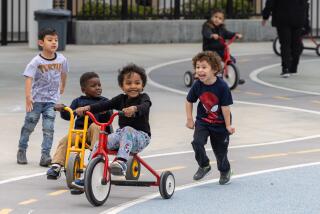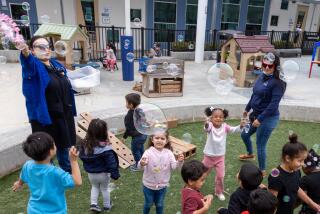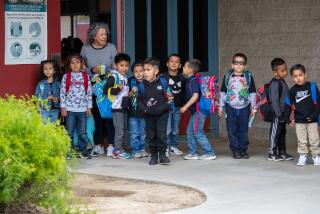What should we want from preschool?
Each morning at Sinan Road Kindergarten in Shanghai, a child stands in front of the class and tells a story. One morning, I watched as 4-year-old Ziyu told a 10-minute story about a group of animals frightened by a strange sound. When he finished, his teacher asked the class: “Shall we make him Storytelling King? Did he do a good job?”
Children called out criticisms. “His voice was too soft.” “It was like a story we’d heard before.” Still, when teacher Wong called for a vote, Ziyu was elected Storytelling King by a 16-4 margin.
We shot video of Ziyu that morning as part of a cross-cultural research project on the different approaches to preschool education in China, Japan and the United States. Many American teachers who later watched this scene worried that the criticism would be harmful to the storyteller’s self-esteem. As one teacher put it, “I’m 35 years old, and if I were criticized like that, I would cry!” But another of the teachers saw things differently: “If we had learned in preschool to give and receive criticism, maybe we could handle it better as adults.”
I thought about Ziyu the other day after President Obama issued his call for making “high-quality preschool available to every child in America.” As we found in our research, the definition of “high-quality preschool” varies widely from one society to another, and a wide range of approaches can serve children well. It all depends on what we view as the goals of early education.
In Kyoto, Japan, for example, older children at the Komatsudani Childcare Center spend an hour each afternoon caring for the babies and toddlers. This activity is seen as equally important for the younger and older children.
In one scene in our video, a 5-year-old boy, Kenichi, teaches 2-year-old Taro how to use the urinal. Positioning Taro in front of the toilet, Kenichi reminds the younger boy to aim and to hold up his shirt tails. He then warns Taro that he is about to flush. When he does flush, the boys scream in a mock display of surprise. They were both having fun, and many of the American teachers who watched this video lamented that such interactions were impossible in their age-segregated classrooms.
The Storytelling King and the urinal lesson are both examples of how preschools help children develop ways of thinking and acting valued by their cultures. The Storytelling King activity combined early literacy skills with public speaking, active listening and giving and receiving criticism. The urinal lesson was an opportunity not just for 2-year-old Taro to learn an important skill from an older child; it also gave 5-year-old Kenichi a chance to practice empathy, and to remember what it was like to be 2 years old.
Chinese educational experts told our research team that they encourage activities like the Storytelling King to teach individual expression and creativity, skills they hope will help develop the kind of entrepreneurial skills China needs to compete in the global marketplace. The morning exercise incorporates a new Chinese focus on self-expression, a traditional Chinese emphasis on mastery of performance and a communist practice of self-improvement through group critique.
Contemporary Japanese preschools, in contrast, emphasize continuity rather than change. Preschools in Japan are key sites for children to be introduced to traditional Japanese values, such as empathy and social-mindedness, values that are seen as at risk in a rapidly changing society.
What is taught in preschool — or not taught — helps shape the ethos of a society’s future citizens. As our country debates Obama’s proposal, we need a thoughtful discussion of what that would mean in the United States.
Because the preschools of each country reflect that country’s cultural beliefs and values, it would be a bad idea to simply copy wholesale another country’s approach. But examining the strengths of preschools in other cultures can help us define what is possible and desirable to aim for in our own.
In a country as culturally, socially, economically and ideologically diverse as the United States, there isn’t likely to be a one-size-fits-all approach that will satisfy everyone. Scholars, policymakers, teachers and parents are already debating the proper balance of academics and play for a preschool curriculum, along with examining how the two can best be combined. We should not expect or desire every community in our country to arrive at the same definition of what should be taught and how. The voices of parents and other community members need to be brought into these discussions.
This doesn’t mean, of course, that preschool teachers and administrators should do whatever parents want. Part of a school’s job is to educate parents as well as children, and to explain, for example, how a play-based curriculum can support cognitive as well as social and emotional development. But this communication should not be unidirectional. Parents will stop coming to school if they sense their views are disrespected.
Our research makes clear that a wide variety of approaches to preschool can be considered “high-quality.” An educational program works best when it combines the contributions of research on best practice with responsiveness to local conditions, concerns and values.
Joseph Tobin, a professor at the University of Georgia, is the author of “Preschool in Three Cultures Revisited” and the forthcoming book “Children Crossing Borders: Immigrant Parent and Teacher Perspectives on Preschool.” https://www.joetobin.net
More to Read
A cure for the common opinion
Get thought-provoking perspectives with our weekly newsletter.
You may occasionally receive promotional content from the Los Angeles Times.










